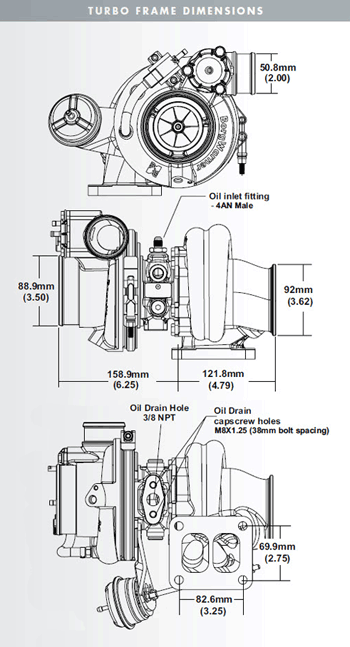
BorgWarner 7670 EFR Ball Bearing T4 Turbo (179390)
Part #: bwa179390
Loaded With Innovations!
Engineered For Racing!
375-650 HP Twin Flow Turbine Inlet Turbo
What kind of turbocharger would you build for your high-performance car? The engineers in BorgWarner's Advanced Aftermarket Product group created a wish list of every notable design characteristic. They used materials that had never been combined into an aftermarket turbocharger. They delivered quick boost response, powerful performance and reliable durability. All combined, the EFR turbocharger line is at the pinnacle of what can be done with the current state of the art while maintaining affordability. It raises the bar in every respect: performance, response, installation, appearance, and value. It is quite simply the best aftermarket turbo that money can buy, and we will continue to raise that bar and provide additional housing and feature options going forward.
The EFR (Engineered For Racing) turbochargers from BorgWarner offer an unprecedented combination of advanced technologies:
Low-weight Gamma-Ti turbine wheels and shaft assemblies for quick boost response Patent-pending dual ceramic ball bearing cartridges for more thrust capacity, durability and turbine efficiency at low expansion ratios Stainless steel turbine housing for increased efficiency, improved durability and corrosion resistance Range of units supporting 225 to 1,000 horsepower per turbocharger.
Compressors
Born from BorgWarner's experience in highly boosted, highly efficient commercial engines, the compressors in EFR turbochargers offer exceptional efficiency, range/width and pressure ratio (boost) capability.
Range: 62mm O.D. (50mm inducer dia.) to 91mm O.D. (68mm inducer dia.)
Turbines
EFR turbine wheels are made from titanium aluminide (or Gamma-Ti). Not quite ceramic and not quite metal, the material is very light-weight and demonstrates excellent strength at high temperatures. Because EFR turbine wheels weigh 50% less than typical turbine wheels, less energy is required to spin up the wheel, allowing the turbocharger to respond faster. BorgWarner EFR turbochargers also feature the newest ''super back'' and ''fullback'' turbine designs for high-boost, high-efficiency applications.
Polish Range: 58mm O.D. to 80mm O.D.
Pairing
BorgWarner engineers pair compressors and turbines to maintain optimal flow for the fastest response. In addition, a range of turbine housing A/R's are available so that you can dial in your desired power range based on your application.
Features:Ultra Low-Mass Gamma-Ti Turbine WheelsMixed-Flow Turbine Blade DesignDual Ceramic Ball Bearing CartridgesAluminum Bearing HousingStainless Steel Turbine HousingFlexible Orientation Compressor CoverForged Milled Compressor WheelsIntegrated High-Flow Wastegate, Boost Control Solenoid Valve, Speed Sensor and Compressor Recirculation ValveWater Cooled Aluminum Bearing HousingStandard T4 Inlet ConnectionSimple OrientationClick Here to See AirWerks Series Turbocharger Application Range Guide
Share this Product
- choosing a selection results in a full page refresh
- Opens in a new window.
- Opens external website in a new window.




